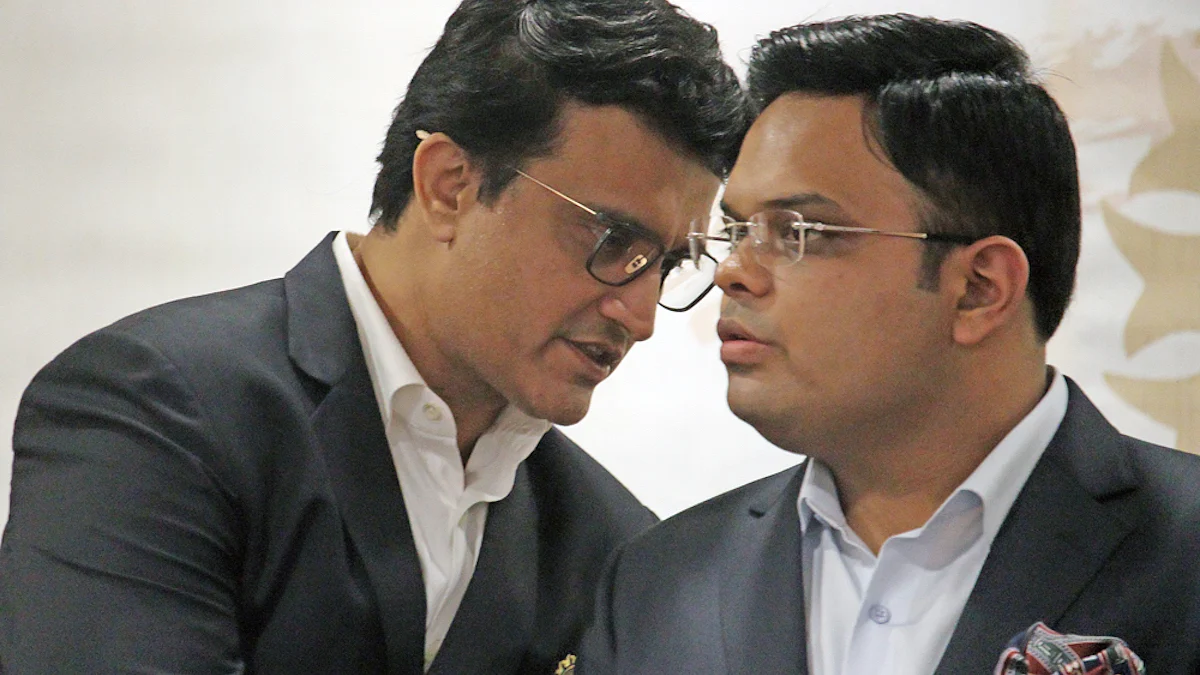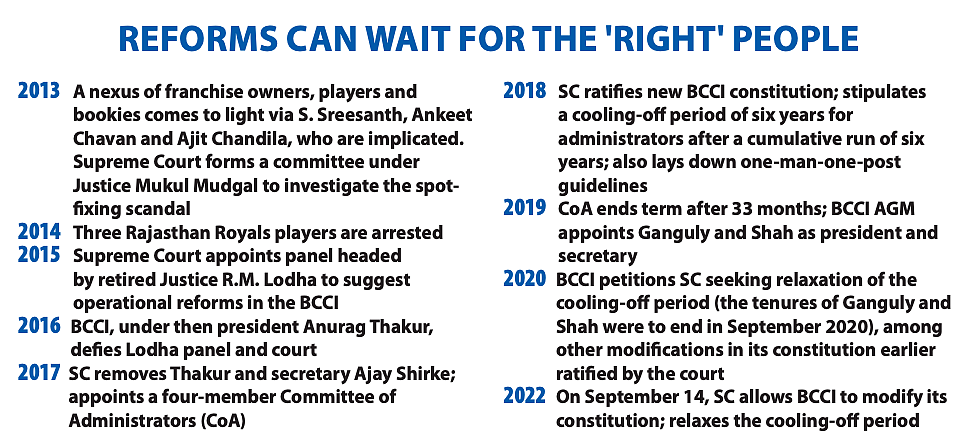After clean-up attempts, power nexus in control at BCCI has had its way
With apex court allowing BCCI to relax the ‘cooling off ’ period for administrators, its president Sourav Ganguly and secretary Jay Shah are set to continue at the helm and have longer tenures

“BCCI thinks it is law unto itself. We know how to get our orders implemented.” –Chief Justice of India, T.S. Thakur, 2016
“Why does Indian cricket prosper? Not because of the intervention of the court but because of the body which runs it.” –Supreme Court Bench of Justice D.Y. Chandrachud and Justice Hima Kohli, 2022
The Supreme Court on September 14 set the clock back on reforms it had initiated six years ago in 2016 in the Board of Control for Cricket in India (BCCI), the world’s richest and India’s most powerful sports body. Eyebrows were raised when an apex court bench headed by Justice D.Y. Chandrachud allowed the BCCI to change its constitution and relax the ‘cooling off ’ period for administrators.
It cleared the decks for BCCI president Sourav Ganguly and secretary Jay Shah—whose tenures had come to an end in September 2020—to continue and have longer tenures.
All the wishes made by the BCCI were in fact granted, barring the one that would have allowed the sports body to make amendments to the constitution without referring to the court.
After the IPL match-fixing scandal broke in 2014, the Supreme Court had stepped in and first formed the Mukul Mudgal committee and thereafter the Lodha panel to recommend steps to clean up the BCCI. The Lodha panel did not mince its words.
“The reins of cricket’s richest and arguably the most powerful national body remains mired in controversy. With an individual-centric constitution and old power centres that have remained unaltered for years, BCCI seems to have strayed from its chosen path,’’ it said in its report.
In an interview to The Indian Express following the court decision to throw out the Lodha panel recommendations, Justice Lodha said: “For the administrators, the cooling off clause was like a snow mountain, which they found very difficult to change, so they just waited for the weather to change. This is how it has been happening since 2016, 2018 and 2022.’’
The original 2016 SC order, based on the recommendations of the Lodha committee, wanted office bearers to take a break after every three-year term. This was then ratified to a cumulative period of six years (either in the state, national body or a combination of both).
Now, they can remain in a state body and the BCCI together for an unbroken stint of 12 years. The court order will enable Ganguly and Shah to continue until 2025, to start with. However, as the dust settles down on last week’s order, there is growing interest on what might unfold at the BCCI's annual general meeting next month.
The buzz is that BCCI may propose Ganguly’s name as the next president of International Cricket Council (ICC) once Greg Barclay’s term ends in November, while Shah fancies his chances of taking over as the youngest BCCI president.
“Our idea of a cooling-off period was based on two factors—it would stop the creation of monopoly and it would bring in new blood into the administration. Cooling-off is a very important limb of the government structure to eradicate the formation of a monopoly…if you give a long tenure, it is bound to create a monopoly in favour of a few individuals,” Justice R.M. Lodha (retd) said in the same interview.
Given the way recommendations have been watered down, it’s difficult to believe that the Supreme Court had, in 2017, removed both BCCI president Anurag Thakur (now a Union minister) and secretary Ajay Shirke for their defiance in implementing the Lodha Committee recommendations.
The state associations, to borrow Justice Lodha’s words, continue to remain ‘power centres’. Political clout and family connections continue to rule the roost. A look at the list of officials of some of the state bodies tells its own story. Bengal cricket body is being run by Abhishek Dalmiya, the son of former BCCI president Jagmohan Dalmiya, and Snehasis Ganguly, the elder brother of Sourav Ganguly, as president and secretary respectively. Adwait Manohar, son of another former BCCI and ICC chief Shashank Manohar, is the boss in Vidarbha.
In Saurashtra, Pranav Amin, son of former BCCI VP and IPL chairman Chirayu Amin, is the president. Jaydev Shah, son of former BCCI secretary Niranjan Shah, is the vice president while Niranjan Shah’s nephew Hinmanshu Shah is the secretary.

Ajit Lele (son of late Jaywant Lele, ex-BCCI secretary) is the secretary of Baroda cricket association and till last year Rupa Gurunath (daughter of ex-BCCI and ICC president N. Srinivasan) was the president of Tamil Nadu cricket body. The Supreme Court had hand-picked a four-member Committee of Administrators (CoA) comprising former Comptroller and Auditor General (CAG) of India Vinod Rai, corporate honcho Vikram Limaye, cricket and social historian Ramachandra Guha and veteran woman cricketer Diana Eduljee to run the BCCI.
However, Limaye stepped down citing personal commitments and Guha soon followed suit, taking a dig at the ‘superstar culture’ prevalent in Indian cricket (his ire was directed at the then captain Virat Kohli having his way at the removal of chief coach Anil Kumble, a Bangalorean like Guha). One could almost see the I-told-you-so smirk among the officialdom across the country. The 33-month tenure of the CoA did have a few high points like changing the ownership pattern of IPL teams and formation of an apex council, but it gradually became untenable with media reports of rift between Rai and Eduljee while the CEO Rahul Johri turned out to be the de facto chief. A big let down was also the way the CoA handled the sexual harassment case against Johri.
The court appears to have concluded that the administration of cricket is best left to the timetested nexus of politicians, industrialists and their henchmen. It is, therefore, back to square one at BCCI—just as the almighty Board would have liked it. Is anyone complaining?
Follow us on: Facebook, Twitter, Google News, Instagram
Join our official telegram channel (@nationalherald) and stay updated with the latest headlines
